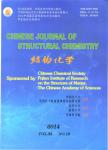Theoretical Study on the Structures and Magnetic Properties of Metal String Complexes Containing Rigid Equatorial Ligands [Ni3(L)4(NCS)2] (L = dzp-, mpmpa-, mppda-, mptpa-)
Theoretical Study on the Structures and Magnetic Properties of Metal String Complexes Containing Rigid Equatorial Ligands[Ni_3(L)_4(NCS)_2](L=dzp^-,mpmpa^-,mppda^-,mptpa^-)作者机构:School of Chemistry & Environment South China Normal University Guangzhou 510006 China Key Laboratory of Materialsfor Energy Conversion and Storage of Guangzhou Guangzhou 510006 China Key Laboratory of Theoretical Chemistry of Environment Ministry of Education Guangzhou 510006 China
出 版 物:《Chinese Journal of Structural Chemistry》 (结构化学(英文))
年 卷 期:2017年第36卷第7期
页 面:1077-1085页
核心收录:
学科分类:081704[工学-应用化学] 07[理学] 070304[理学-物理化学(含∶化学物理)] 08[工学] 0817[工学-化学工程与技术] 0703[理学-化学] 081201[工学-计算机系统结构] 0812[工学-计算机科学与技术(可授工学、理学学位)]
基 金:supported by the Natural Science Foundation of Guangdong Province(S2012010008763) Ministry of Education and Guangdong Province(2010B090400184) Science and Technology Program of Guangzhou City(2011J4300063)
主 题:metal string complex rigid equatorial ligands density functional theory magnetic coupling constant
摘 要:Density functional theory at the BP86 level was used to investigate the influence of equatorial ligands on the Ni–Ni interactions and magnetic coupling properties of metal string complexes [Ni3(L)4(NCS)2] (L represents the rigid equatorial ligands; L = dzp- (1), mpmpa- (2), mppda- (3), mptpa- (4)). The following conclusions can be drawn. (1) With increasing the radius of the connecting atom in the cental ring in equatorial ligands, the two pyridine rings bend down, resulting in the decreasing distance between the two pyridine-nitrogen atoms and the Ni–Ni distance. Therefore, the strength order of the Ni–Ni interaction is 4 〉 2 〉 3 〉 1. The Ni–Ni interactions in 2 and 4 are stronger than those in Ni3(dpa)4(NCS)2 containing no-rigid equatorial ligands. (2) The calculated -Jab is 4 〉 2 〉 3 〉 1. There are two types of magnetic exchange pathways in these complexes: the σ-type pathway through the Ni36+ chains and the δ-type pathway through the equatorial ligands. The magnetic coupling through the metals is the dominant part. Hence, the magnetic coupling strength increases with increasing the Ni–Ni interaction. Modifying the radius of the connecting atom may be one of the means to fine tuning of magnetic coupling strength of this kind of metal string complexes.



